Coronavirus Higher Education Industry Briefing: May 5
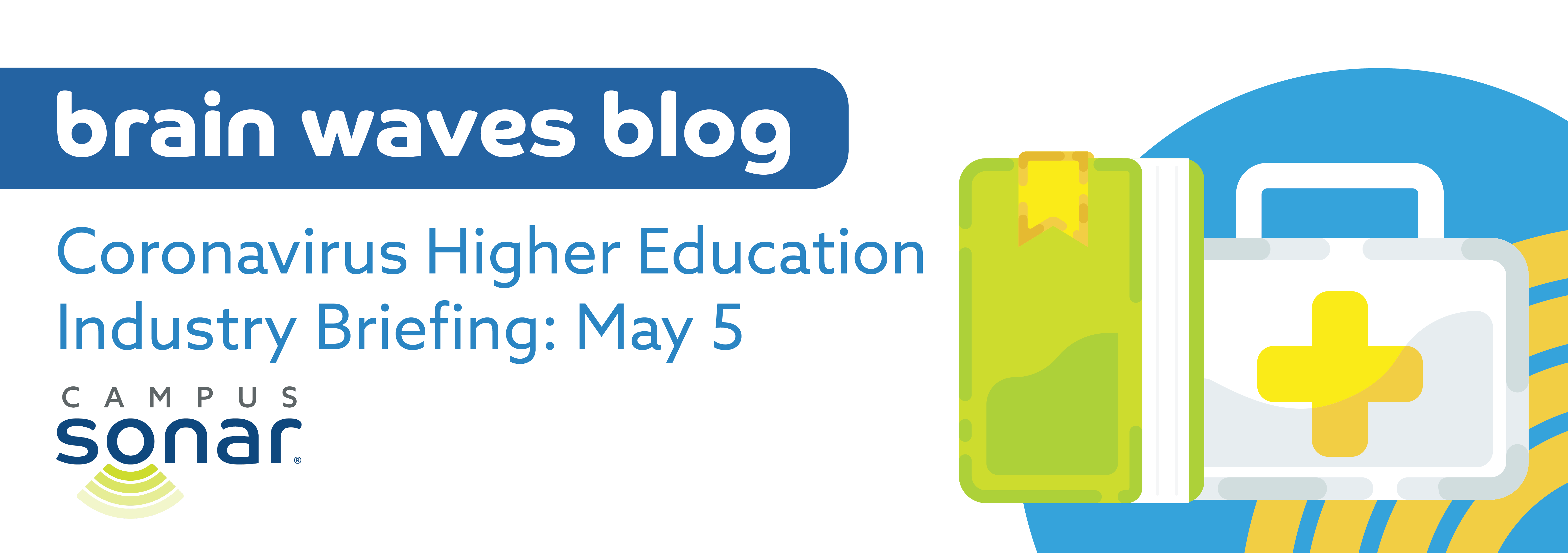
Community Colleges' Time to Shine
Today’s Briefing analyzes publicly available online conversation in the U.S. and on Reddit and YouTube (which span beyond the U.S.) about the coronavirus and higher education from April 27–May 3. In this analysis of volume, topics, and sentiment, we highlight conversation about community colleges, Zoom University, and President Trump.
If you’d like to receive each Briefing in your inbox as soon as we publish it, sign up at info.campussonar.com/covid19. You can also review all prior Briefings. Because of the changing nature of social media data and our understanding of the conversation, each Briefing covers a distinct point in time. Comparisons from Briefing to Briefing may be helpful, but we can’t draw correlations like we could if we were using other datasets such as surveys or historical social media data.
Download a slide deck with the data from this post.
Higher Ed in the Spotlight, Despite Volume Decrease
We identified almost 375,000 conversations about the coronavirus and higher education April 27–May 3, ranging from 29,000–80,000 mentions per day. This is about 15 percent fewer mentions than the week earlier. Sixteen percent of all mentions related to the fall semester or beyond (double the percentage of the week prior).
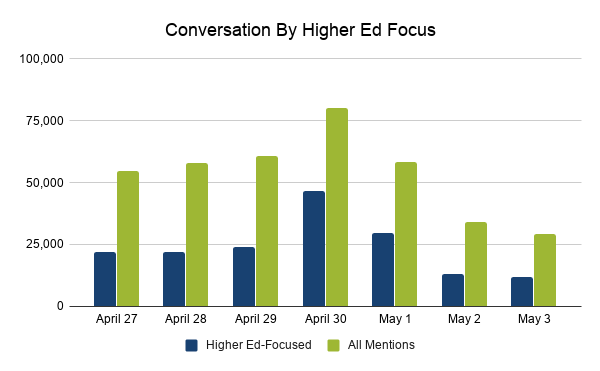 Forty-five percent of all mentions were higher ed-focused, a new high since we’ve published the Briefings. Remember, our industry-level analysis only captures general higher education mentions. If someone mentions the name or acronym of an institution without using a higher ed term (e.g., campus, university, college, classes, etc.), it’s not included in this analysis. Actual volume of conversation across the industry is likely much higher.
Forty-five percent of all mentions were higher ed-focused, a new high since we’ve published the Briefings. Remember, our industry-level analysis only captures general higher education mentions. If someone mentions the name or acronym of an institution without using a higher ed term (e.g., campus, university, college, classes, etc.), it’s not included in this analysis. Actual volume of conversation across the industry is likely much higher.

Moving Into the New Normal
While we’re seeing fewer mentions week-to-week, I’m not convinced the conversation is actually decreasing. Rather, the way people talk about higher education and the pandemic is changing. As we figure out our new normal, the pandemic has become an accepted part of the present as well as the future. It’s not necessary to mention “coronavirus,” “COVID-19,” or even “online classes” when talking about its impact on the industry. Most conversations about fall semester, tuition prices, campus budgets, and college choice—both online and off—have a tie to the pandemic whether or not it’s explicitly referenced. Campus Sonar never intended to analyze all industry conversations regularly, for free. As much I would love to, that’s not much of a business model. We’re currently considering how we can continue to provide this analysis, as well as what opportunities may provide ongoing industry analysis in a way that’s sustainable for our business as well as accessible for you. If you have thoughts on that, I’d love to hear from you. Now, on with the Briefing!
More Fall Semester Conversation on Social Media
As predicted in the April 21 Briefing, conversation about the fall semester and beyond has increased on social media, both in volume and as a percentage (56 percent). Social media remains the largest source of conversation for all mentions and higher ed-focused mentions, while over half of first-person mentions from students are on forums (mostly Reddit).
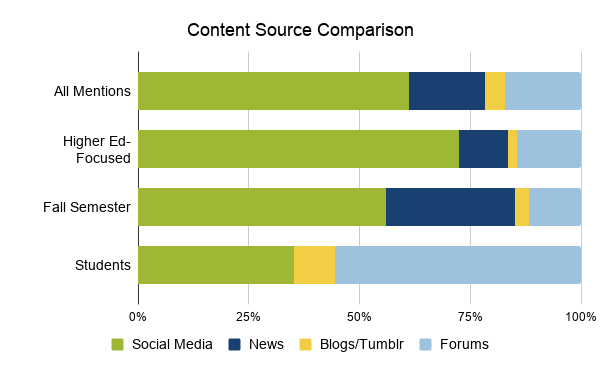 Remember that due to data access restrictions, we aren’t including Facebook, Instagram, Snapchat, TikTok, or LinkedIn in our analysis. Your campus social media manager is the best source of information regarding conversation on those networks. Depending on the software used, social listening for a specific campus can include Facebook and Instagram mentions once account managers verify admin access.
Remember that due to data access restrictions, we aren’t including Facebook, Instagram, Snapchat, TikTok, or LinkedIn in our analysis. Your campus social media manager is the best source of information regarding conversation on those networks. Depending on the software used, social listening for a specific campus can include Facebook and Instagram mentions once account managers verify admin access.
Community College Is the Most Popular Higher Ed-Focused Topic
The following word cloud includes the top 100 people, phrases, and emojis in higher ed-focused conversation April 27–May 3. There are three topics within the top ten that haven’t been covered in-depth in prior Briefings: community college, Zoom University, and Trump. We’re going to dive into each of those, as well as “black,” which was one of the 15 topics covered in detail in the April 21 Briefing.
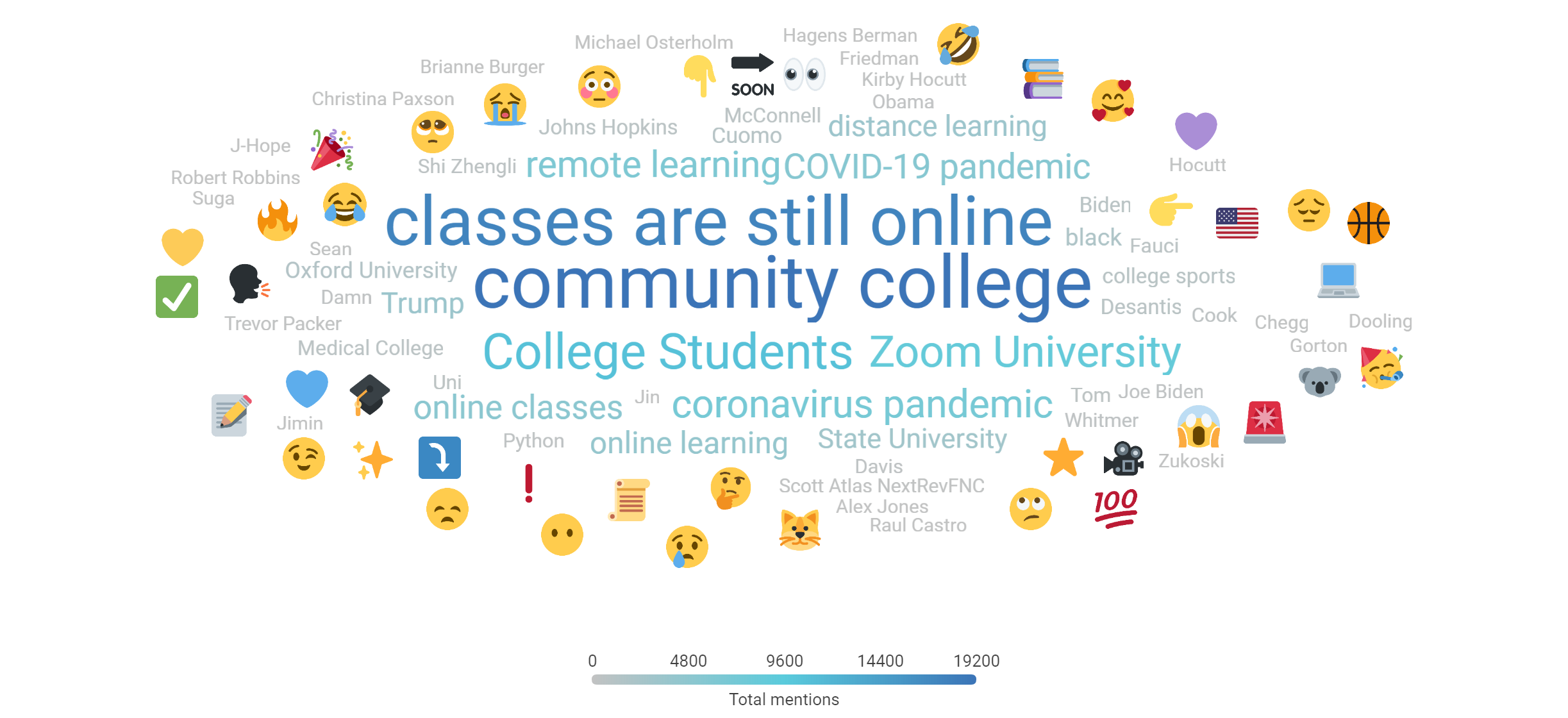
Community College: Viral Tweets, National Decision Day, Industry, and Popular Media
“Community College” was the most-used phrase in higher ed-focused conversation. This was largely driven by a viral tweet that stated, “If you’re an incoming freshman and classes are still online next semester, please save your money and enroll in a community college.” The tweet’s author has just over 3,000 followers, so the nearly 250,000 engagements on this post aren’t because they’re a popular internet personality; it’s because the message resonated. Has there ever been a better time to #EndCCStigma?
This tweet showed up 17,360 times in our dataset. It accounted for 90 percent of community college mentions, 46 percent of mentions about the fall semester, and about 10 percent of all higher ed-focused mentions. But even without this viral tweet, “community college” would still be in our top twenty higher ed-focused topics. Some of the other community college mentions expressed the same sentiment, including the following retweets of the viral tweet.
- Especially for those of you who are low-income, please do not go into debt for online classes.
- Whether classes are online or not: 10/10 recommend community college for the first two years.
- Community colleges are the smart choice for almost every single new college student I know, and for most older students, too. Corona or no corona. Online or in-person. They are the best, smart choice.
- I would recommend community college to anyone, even if classes weren't online. It saves you so much money and you still get a formal, well-rounded education. I've found professors at community college care just as much, if not more than professors at a university.
The viral tweet is still being retweeted, often with comments. Here’s what people are saying when they add a comment to their retweet. Another popular tweet thread about choosing community college, from a DeAnza College graduate who now attends UC Irvine, has over 4,000 shares. Although it was published April 24, it was still being shared last week so some retweets appeared in our dataset.
On National Decision Day, one student proudly tweeted that she got into six universities but chose community college (Santa Monica College) because she’s “not paying 20k to stay home when I can do it for free.” She later commented that she was accepted to six Historically Black Colleges and Universities (HBCUs) and plans to transfer to UCLA in 2022. Despite having just over 500 followers, her tweet about choosing Santa Monica received over 500 engagements. Another student commented, “you just inspired me to post my community college.” She followed through, posting her decision to attend West LA College to major in nursing, planning to later transfer to California State University, Northridge. Her tweet has over 300 engagements.
Just a handful of mentions from students pointed out that the same instructors were teaching online courses for both community colleges and four-year institutions, wondering what made the latter worth a higher price of tuition. A redditor, posting in the r/boston subreddit, replied in a discussion about Boston University students suing for a refund, “I went to community college with the intention of transferring to a 4 year, was offered a job from an internship instead. I work with people who went to MIT. They all pretty much agree I won.”
Some other community college mentions were from industry sources, including:
- Community College Research Center: How Will COVID-19 Affect Community College Enrollment? Looking to the Great Recession for Clues
- Matt Reed’s Inside Higher Ed column: The Visiting Year
- The Key With Inside Higher Ed podcast episode: How Community Colleges Are Planning for the Fall, and Beyond
Mass media also covered community colleges. A Strada Education Network survey analysis, announced April 29 and mentioned in multiple news outlets, mentioned that although the percentage of Americans intending to pursue additional education over the next five years hasn’t changed, there was “a marked increase in their likelihood to enroll in a trade school, community college, or online only college or university.” Earlier in the week, the Detroit Free Press (part of the USA Today network) presented a more pessimistic view: Will students show up for college in fall 2020? Community colleges offer a hint. It isn't pretty.
Finally, I saw at least two mentions of community colleges offering enrollment incentives. Vance-Granville Community College announced a buy one, get one free summer enrollment initiative for both in-state credit and non-credit students interested in online courses. The offer is also available to current students. Southwest Tennessee Community College is offering five self-paced online courses for free to help the local community upskill.
If you’re a community college staff member reading this, you may find value in the Missouri Community College Association webinar I participated in on April 28, Overcoming Enrollment Obstacles. If you want my email with follow up resources, just give me a shout.
Zoom University: A Meme and a Red Herring
The fourth most common higher ed-focused topic is “Zoom University.” We intentionally added this term to our query in March when we noticed students used the phrase to refer to their online course experience. Eighty-five percent of the Zoom University conversation came from a SpongeBob meme suggesting an undersea world on fire upon the announcement of online classes for the fall (we talked about why memes matter in the March 27 Briefing).
Other than the occasional off-handed mention (including the proud announcement of a sleepy cat planning to study napping at Zoom University), the remaining mentions appeared in what some students and parents may interpret as the mainstream media. The Denver Sun, Texas Guardian, and others (all members of a content distribution network from iCrowdNewswire) ran an article without a credited author titled How Colleges Are Handling Refunds During the Coronavirus Pandemic. The article includes the sentence, “A common feeling is that Zoom university [sic] is not worth $40,000 per year.” While I don’t expect readers of this Briefing would consider this legitimate journalism, when it appears in the Facebook feeds of parents alongside a news site claiming an affiliation to a major higher education market like Boston, Houston, Los Angeles, or Philadelphia, it has the potential to inform public opinion—especially when a legitimate ad from a respected college or university appears alongside the article (yep, I saw that).
This is representative of a larger issue for campuses that spans public opinion, media relations, and advertising strategy, particularly when hundreds of institutions are still accepting applications for the most unpredictable academic year yet. I spoke with Teresa Valerio Parrot, principal of TVP Communications, to get her take on this specific news network (which includes the Denver Sun, suspiciously similar to one of her local news sources, The Colorado Sun) and implications for campus strategy.
“These sites appear to be using content shared through creative commons licensing, so they are able to pull in news from credible sources like The Conversation and less credible news from other sites and outlets. These are news aggregators with the sole purpose of getting ad revenue, not distributing news. You need to be careful about where you’re putting your ad revenue, because this is today’s equivalent of advertising during Jerry Springer ten years ago. It’s easy to get caught up in distribution numbers, and lose track of who and what they represent. Some advertising organizations will use these types of outlets and aggregators alongside those with credibility, like the Business Journal Network. Aggregator networks can be included in an advertising bundling to artificially inflate number of views and households reached. Do your research, because with your purchase you are allowing your brand to buoy theirs.”
Trump: Professor and Politics
“Trump” was the tenth most popular topic of higher ed-focused conversation. While almost all Trump mentions are political in nature, one subtopic rose to the top. Thirty-four percent of higher ed-focused mentions that included the word Trump referenced a Twitter thread from a Rutgers University associate professor. Dr. Brittney Cooper is the author of Eloquent Rage: A Black Feminist Discovers Her Superpower and co-editor of The Crunk Feminist Collection, which explains her Twitter handle, @ProfessorCrunk. On April 28 she shared her thoughts on the disproportionate number of Black people dying from COVID-19 and the people pushing to reopen the country with her 100,000 followers. The next day, her tweets were covered by conservative-leaning sites Campus Reform and The Blaze, which highlighted her campus’s name and the political nature of her tweets. These articles then prompted more social media commentary and harassment targeting Dr. Cooper.
Black: HBCUs and the Black and Brown Communities
I continue to notice the word “black” hovering in our top twenty topics. This week it was the thirteenth most popular higher ed-focused topic; when excluding viral tweets about community college and Zoom University, it’s number ten. After removing mentions of phrases like black beans, black swan, and black belt, I identified 1,420 mentions from or about black and brown people. (I conducted a similar analysis in the April 21 Briefing.) In total, they demonstrate how conversation about the impact of COVID-19 on black and brown communities is being discussed both within the context of higher education and by campus-affiliated experts. I won’t be surprised to see this conversation topic grow over time.
The most prevalent topic in this conversation is once again the work scientists at Meharry Medical College are doing to develop a coronavirus antiviral drug. An NBC News article originally published on April 16 was tweeted on April 29 by @NBCBLK, an NBC property for elevating America’s conversation about Black identity, politics, and culture. The tweet received about 1,500 engagements, resurfacing the story for many new readers.
HBCUs were another popular topic. The Reverend Al Sharpton tweeted a clip from his interview with Thurgood Marshall College Fund president and CEO Dr. Harry Williams with the comment, “historically black colleges and universities are struggling as the coronavirus pandemic continues to sweep the country.” Other HBCU mentions included analysis of CARES Act funds and coverage of the impact of NFL recruitment cancellations on HBCU players’ chances of getting drafted.
Other mentions included the phrase “black community.” New America California hosted an online conversation, COVID and Education: Black Students’ Distance Learning and College Transitions. Promotions started for a May 5 radio conversation with Chicago State University faculty, Debunking the Myths: COVID-19 In the Black Community. Errin Haines, editor at large for The 19th, shared a quote from Howard University president Wayne Frederick, adding that he “should be quoted more as a black doctor can speak to multiple impacts of the black community in this pandemic, not least of which include colleges, public health and immigrant communities.”
Finally, a retweet of an April 7 tweet from COVID Black appeared in this dataset. It links to a template for university employees to send a letter to their local health departments, asking to report racial and ethnic demographic data for testing, treatment, and death rates related to COVID-19. The COVID Black Twitter account was created in April 2020. Its bio states it is “a rapid response task force and a critical Black DH project created to respond to Black Diasporic communities impacted by the coronavirus pandemic.”
Higher Ed-Focused Sentiment Improved
A smaller percentage of the higher ed-focused conversation was negative (16 percent compared to 21 percent the week prior) and more was positive (13 percent compared to 11 percent). Sentiment from campus audiences was similar to last week.
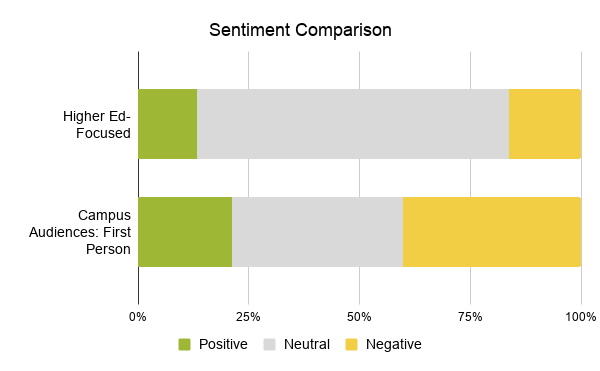 What We’ve Learned from Admitted and Current Student Conversations
What We’ve Learned from Admitted and Current Student Conversations
Our topics included a variety of student discussions, so in-depth analysis of students and other first-person campus voices isn’t included this week. We’re not leaving you hanging, though. Steve App and I created a 45-minute online presentation reviewing what we’ve learned from admitted and current student conversation during the pandemic. We presented it in cooperation with the Southern Regional Education Board last week, and you can view the recording and download our slides whenever it’s convenient. Feel free to reach out if you want the follow-up email full of resources.
Summary and Recommendations
Conversation volume decreased 15 percent compared to the prior week. Sixteen percent of all mentions referenced the fall semester (twice as much as last week). Forty-five percent of all mentions were higher ed-focused—the highest we’ve ever reported in a Briefing. Community college was the top topic of conversation, propelled by viral tweets encouraging students to choose a community college this fall if four-year campuses were holding classes online. Another top topic, Zoom University, was fueled by a SpongeBob meme expressing angst around an online fall semester. Higher ed-focused sentiment improved slightly, with less negative conversation and more positive conversation. Sentiment from campus first-person audiences was consistent with last week.
- Accept that all communications are COVID-19 communications. I know you spent time and money on your pandemic microsite and front page notice, and I’m not expecting you’ll take it down today. However, it’s time to recognize there are pandemic undertones in everything you say, and everything your audience thinks about. Every communication should consider that, and every inbound message should be read for two levels of meaning: its stated subject and an opportunity to model a pandemic response.
- Community colleges should take advantage of their unique position. Your target market has expanded, at least for fall semester. If you’re not already well-versed in digital advertising, now is the time to quickly level up or find a trusted partner. Students who never would have considered your campus may see you as a viable option right now (as may their parents). Any community college that doesn’t have an expanded marketing strategy to reach local students ultimately headed for four-year institutions in place by June 1 is missing that opportunity. And to the four-year institutions reading this, don’t be salty. This is your chance to ensure your transfer pathways with community colleges are strong. Hopefully they already are, since community college transfer has always been in the best interest of some students.
- Double-check your display advertising purchases. You likely already did this when fractions of the public started categorizing media sources as unacceptable. In addition to scanning for fake news or deeply partisan editorial, look for aggregators that push sub-par content under deceiving mastheads. Don’t let your brand prop up theirs.
- Watch our webinars. Last week Sonarians gave four online presentations. Two focused on our research from these Briefings and they’re both available free, on-demand. Watch Overcoming Enrollment Obstacles (geared towards community colleges) and Using the Science of Social Listening to Understand and Meet Students' Needs (focused on admissions). Everyone who attended these webinars got follow-up emails packed full of supplemental resources. Email me if you want one of your own.
Stay Connected with Future Briefings
The Coronavirus Higher Education Industry Briefing is Campus Sonar’s first real-time industry research project. If you find it valuable, please let us know (tweet us at @CampusSonar, email info@campussonar.com, or comment on this post). If you’re regularly sharing this Briefing with your staff, or referring to it in meetings as you plan strategy, I’d love to hear from you.
We’ll be back on Tuesday, May 12 with our next Briefing.
Download slides and receive future Briefings.
Don't miss a single post from Campus Sonar—subscribe to our monthly newsletter to get social listening news delivered right to your inbox.
 The post Coronavirus Higher Education Industry Briefing: May 5 originally appeared on Campus Sonar's Brain Waves blog.
The post Coronavirus Higher Education Industry Briefing: May 5 originally appeared on Campus Sonar's Brain Waves blog.

